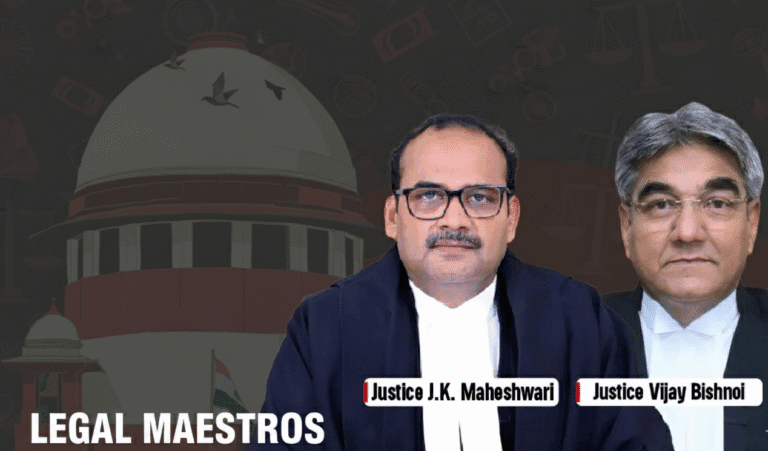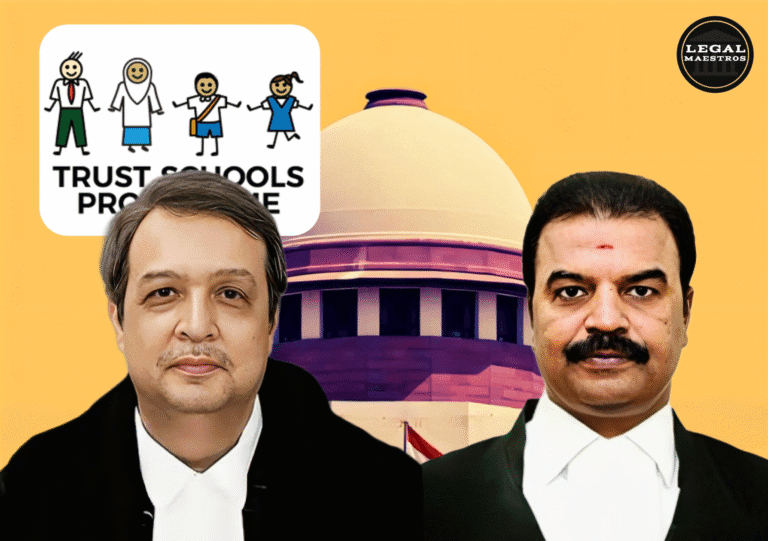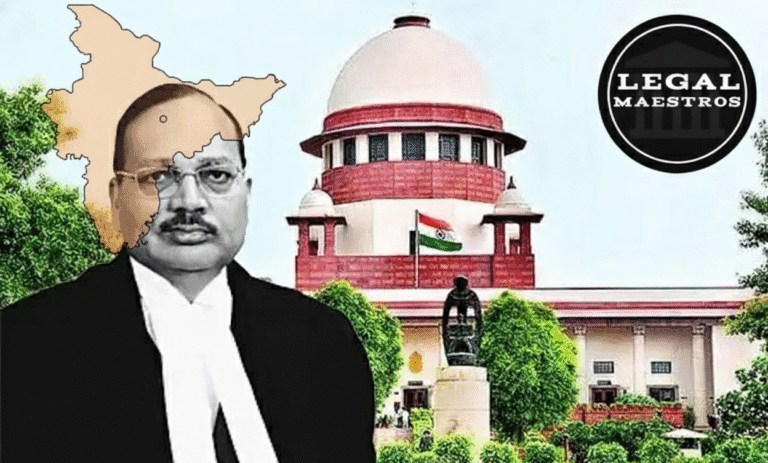
A very recent notable judgment of the Supreme Court of India was in a case involving Kattavellai @ Devakar in the state of Tamil Nadu wherein a man who was alleged to have committed double murder and raped was convicted and told to die by the courts but the Supreme Court reversed the conviction and the death penalty. With the ruling delivered with the date of July 15, 2025, the case indicates important points on criminal trials, in regards to their dependence on circumstantial evidence and the scrupulous examination of the procedures of investigations. The Court placed a lot of stress on the fact that to carry conviction on the basis of circumstantial evidence, there has to be such chain of events in existence that it removes any possible doubt of the guilt of the accused and that no other eventuality can be taken into account.
Short Case of Facts
The case dates back to May 14, 2011, when the two young people; Ezhil Muthalvan (D1) and a female victim (D2) left their houses under different excuses and went to a famous locating place; Suruli Falls and met there. Rajkumar (PW-5) and Bhagyalakshmi already had been there, and they were a couple of others. The appellant, it was alleged, first approached Rajkumar and Bhagyalakshmi and asked them to give jewelry. After realizing that the jewelry was not original, he later on confronted D1 and D2 where they declined to exchange some money and gold and so they were murdered gruesomely.
The bodies of the victims were found days after a complaint was made about a missing person and D2 and D1 bike was found strewn by the falls though in highly decomposed bodies. Postmortem showed that deaths were homicidal in both cases and D2 was sexually assaulted too. Acting on the tip by PW-5 the appellant was apprehended on May 28, 2011, and supposedly provided a confession which resulted in the seizure of some of the items. There was a Test Identification Parade (TIP) and PW-5 was able to identify the appellant.
For any queries or to publish an article or post or advertisement on our platform, do call at +91 6377460764 or email us at contact@legalmaestros.com.
Law, Legal Provisions and Essential Matters
The case brought against the appellant initially against all the sections 302 (Murder), 376 (rape), 397 (robbery) on the charge of attempt to cause death or grievous hurt on Indian Penal Code (IPC) 1860 and chronicles 3 (2) (v) of the Scheduled Caste and Scheduled Tribe (Prevention of Atrocities) Act, 1989. The High Court increased the death penalty of the appellant of Section 302 IPC and Section 376 and 379 IPC on the ground of the murder conviction meted out by the Trial Court depending upon the murder of D2.
The basic questions that were faced in the Supreme Court were whether the circumstantial evidence which was given was sufficient and whether it can hold up a conviction especially of death sentence. The Court was very careful in studying the principles that circumstantial evidence should follow by looking at the precedent set forward by the associates.
Hanumant v. State of M.P. and Sharad Birdhichand Sarda v. Maharashtra state. The panchsheel principles of
For any queries or to publish an article or post or advertisement on our platform, do call at +91 6377460764 or email us at contact@legalmaestros.com.
Sharad Birdhichand Sarda provide that a situation that results in guilt needs to be proved beyond doubt, in line with the guilt of the accused, final, exclude all other possibility than the guilt, and a chain-link evidence.
A Trial Judgment and a High Court Judgment
There was no direct evidence upon which the Trial Court had used to find the accused guilty. In passing this death penalty, there are many points which the High Court took into consideration and they include last seen theory, arrest, confession and recovery, Test Identification Parade (TIP), DNA evidence and a motive. It drew the conclusion that adverse inference against the accused, the recovery of material objects, the rape proved by DNA, circumstance of D1 and D2 last seen with the accused and circumstance of the accused being seen with a weapon all took place beyond reasonable doubt.
Important Arguments by the Appealer
The counsel of the appellant contended that PW-5 was a dubious and a planted witness who had been very unnatural when it came to talking about the incident and the postponement of TIP. It was argued that the identity of the appellant was not a matter of concern since he was already identified through news stories and PW-5 had seen him at the police station prior to the TIP and therefore the identification was a moot point. Moreover, non-examination of Bhagyalakshmi whom was a material witness was questioned. The circumstances of the arrest, the verisimilitude of the disclosure statement and the restored articles raised doubts, because the weapon and the clothes were not examined using forensics and the DNA evidence had problems regarding the chain of custody. Lastly defense claimed that the motive was not established clearly.
For any queries or to publish an article or post or advertisement on our platform, do call at +91 6377460764 or email us at contact@legalmaestros.com.
Important State Positions Electricity The State contends that electricity is an important component in the state thus not fulfilling the element of transport.
In its turn, the State tried to protect credibility of PW-5 claiming that there was nothing significant in terms of delay in reporting and that the witness had not seen the picture of the appellant prior to TIP. They stated that confession statement and retrieval of items were good and PW-4 identified the recovered chain as that of D2. The State also had the following argument, that the testimony of PW-37 proved the rape and the DNA report was in good custody.
Supreme Court on Analysis of Circumstantial Evidence
The Supreme Court pointed out that it did not have any eyewitnesses to the crime and the conviction was purely circumstantial. The Court did the same saying the standards are higher in convictions based on kind of evidence and described situation needing to be sorted out as an absolute chain of facts that merely leads to conviction not the potential innocence.
Criticism of Evidence by Supreme Court
The Court closely examined every bite of circumstantial evidence:
For any queries or to publish an article or post or advertisement on our platform, do call at +91 6377460764 or email us at contact@legalmaestros.com.
Theory of the Last Seen
Although the Court considered making the last seen theory a weak piece of evidence, it held that there may be conviction on the basis of this theory in case it is combined with other circumstances like the discovery of the body is not far, and the accused person does not offer any plausible explanation. The Court however equally cautioned that despite the concession granted to prosecution, it by no means gets relieved of the responsibility of proving the case beyond reasonable doubt.
Arrest, Confession and Recovery
The Court considered the facts surrounding the arrest of the appellant as suspicious since there happened to be no independent witness when arresting the appellant. On the confession statements, the Court held that extra-judicial confessions present poor items of evidence; and are to be corroborated independently, more so when it has presented with suspicious circumstances. Although such recovery of articles – though it could be admissible under Section 27 of Indian Evidence Act – was held unreliable because no forensic examination of the weapon and clothes was done and irregularities were there in the disclosure statement.
Test Identification Parade (TIP)
The Supreme Court found the manner in which the lower courts took the TIP to be a circumstance against the appellant just astonishing since the irregularities were great. It observed that PW-5 witnessed a meeting with the appellant at the police station prior to the TIP and even Police authorizes told him that indeed the appellant had committed the crime thereby rendering the TIP of no consequence. To be admissible in court, the Court stressed that no prior chances should be given to witnesses to view the accused or photographs of an accused.
For any queries or to publish an article or post or advertisement on our platform, do call at +91 6377460764 or email us at contact@legalmaestros.com.
DNA Evidence
Excruciating delays and the impossibility to verify the chain of custody as well as the risk of its contamination rendered the gathered DNA evidence useless. Also, the post-mortem analysis itself was made at the crime-place, which is quite problematic, as far as it can be contaminated. The Court raised the issue of inconsistency and standardized practices in taking DNA samples, storing and transferring the same in investigating authorities.
Faulty Investigation
The Supreme Court decided that none of the situations as discussed by the prosecution were accurately proved against the appellant. The circumstantial evidence chain was fragmentary, it did not establish the guilt of the accused exclusively and, therefore, it did not exclude the innocence of the accused or the care of other persons. Another issue raised by Court was on the issue of the investigation itself like the failure to examine a crucial witness (Bhagyalakshmi).
Consequently, conviction of Kattavellai @ Devakar was set aside and he was to be released forthwith unless needed in any other case. The judgment is an excellent reminder about the standards of proof in criminal justice that needs to be extremely high, especially in circumstances where conviction may be made on purely circumstantial evidence, and the importance of correct procedures of conducting investigation and safeguarding of any evidence. The Court, additionally, made notes relating to the issue of remedy to the wrongful conviction after undergoing long periods in prison through reference to a past judgment and Article 21 of the Constitution in relation to a speedy trial.
For any queries or to publish an article or post or advertisement on our platform, do call at +91 6377460764 or email us at contact@legalmaestros.com.




![Research Assistantship @ Sahibnoor Singh Sindhu, [Remote; Stipend of Rs. 7.5k; Dec 2025 & Jan 2026]: Apply by Nov 14, 2025!](https://legalmaestros.com/wp-content/uploads/2025/11/Gemini_Generated_Image_s0k4u6s0k4u6s0k4-768x707.png)
![Karanjawala & Co Hiring Freshers for Legal Counsel [Immediate Joining; Full Time Position in Delhi]: Apply Now!](https://legalmaestros.com/wp-content/uploads/2025/11/Gemini_Generated_Image_52f8mg52f8mg52f8-768x711.png)
![Part-Time Legal Associate / Legal Intern @ Juris at Work [Remote]: Apply Now!](https://legalmaestros.com/wp-content/uploads/2025/11/ChatGPT-Image-Nov-12-2025-08_08_41-PM-768x768.png)
![JOB POST: Legal Content Manager at Lawctopus [3-7 Years PQE; Salary Upto Rs. 70k; Remote]: Rolling Applications!](https://legalmaestros.com/wp-content/uploads/2025/11/ChatGPT-Image-Nov-12-2025-08_01_56-PM-768x768.png)